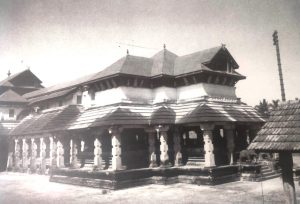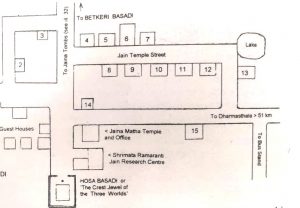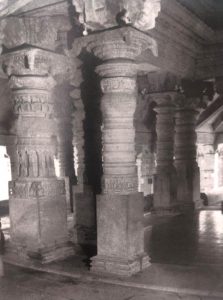Moodabiri
 Moodabidri’s Thribhuvana Tilaka Chundamani Basadi, meaning ‘The Crest Jewel of the Three Worlds’, but better known as Hosa (new) Basadi. A temple which was built in stages between 1430 and 1516, being the last of the town’s eighteen Jaina temples. The presiding Jina in the sanctum is a nine foot (2.74 m) high bronze statue of Chandranatha, it bears an inscription dated March 27, 1430. Two Jaina queens, Chitradevi and Bhairadevi by name, are credited with the construction of the two pillared front halls (opposite).
Moodabidri’s Thribhuvana Tilaka Chundamani Basadi, meaning ‘The Crest Jewel of the Three Worlds’, but better known as Hosa (new) Basadi. A temple which was built in stages between 1430 and 1516, being the last of the town’s eighteen Jaina temples. The presiding Jina in the sanctum is a nine foot (2.74 m) high bronze statue of Chandranatha, it bears an inscription dated March 27, 1430. Two Jaina queens, Chitradevi and Bhairadevi by name, are credited with the construction of the two pillared front halls (opposite).
1-Badaga Basadi
2-Settara Basadi
3- Hire Basadi
4-Koti Basadl.
5-Guru Basadi
6- Leppada Basadi
7 – Deramma Setty Basadi
8- Vikrama Setty Basadi
9-Kallu Basadi
10-Chola Setty Basadi
11- Mahadeva Basadi
12-Batkana-Thikari Basad
13-Kere Basadi
14-Pathashala Basadi
15-Padu Basadi
Moodabidri (also Mudbidri), set amidst a countryside of hills, woods, lakes and fertile fields, and occasionally referred to as the Jaina Kashi (Varanasi or Benares) of South India, has been blessed with outstanding individuals among its Jaina community since early times, both men and women.
They were the ones who had temples build, who collected and preserved valuable manuscripts, and who withstood, feerlessly and wisely, the not always peaceful attempts of kings and feudatories to eradicate Jainism altogether. At times, the temptation was great to yield to such pressures and change one’s religious conviction for reasons of material gain or physical survival.
Many succumbed, for Jainism does not subscribe to a doctrine of justifiable ‘holy wars’. The religion of ahimsa must not be built on himsa (violence). There is a story of a south Indian Jaina monk of high standing who refused to flee from a burning temple, but his martyrdom, though admired, was never advocated as an example to be followed.
Surprisingly, though the Jaina population of Moodabidri town has dwindled to about sixtiy-five and in the surrouning villages to approximately three hundred families, there are as many Jaina as Hindu temples in Moodabidri, namely eighteen each.
Of the Jaina temples, most of them are located on both sides of a so-called Temple Street which places them within walking distance from the Digambara Jaina Matha in the town’s main thoroughfare.
This matha, seat of the Bhattaraka Shri Charukirthi Swami, has an information office for pilgrims and tourists, a dharma- shala for about a hundred pilgrims and some guest-houses. Overseas visitors are welcome.
Moodabidri is famous for its many old manuscripts and treasures of Jaina sculp- tures.
One outstanding piece is an almost three metre high Parshvanatha image made of black stone that was, according to tradition, discovered in a bamboo grove under a heap of debris at the beginning of the eighth century.
The temple in which it was installed and in which it still stands, popularly called Guru Basadi, was built in 714.
Hosa Basadi. Pillars in the hall built by queen Bhairadevi. Though of stone, a strong influence of wooden architecture is evident.